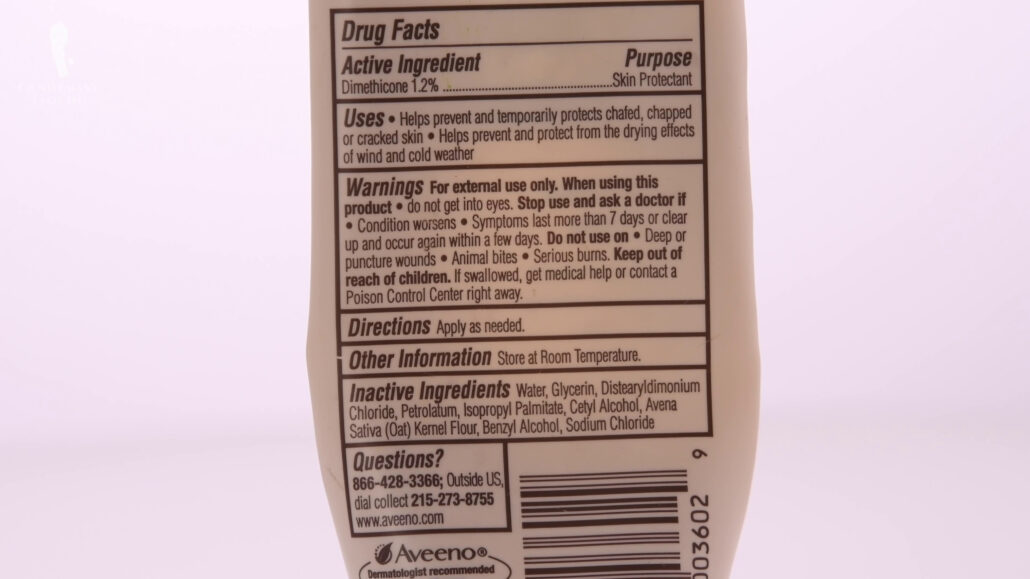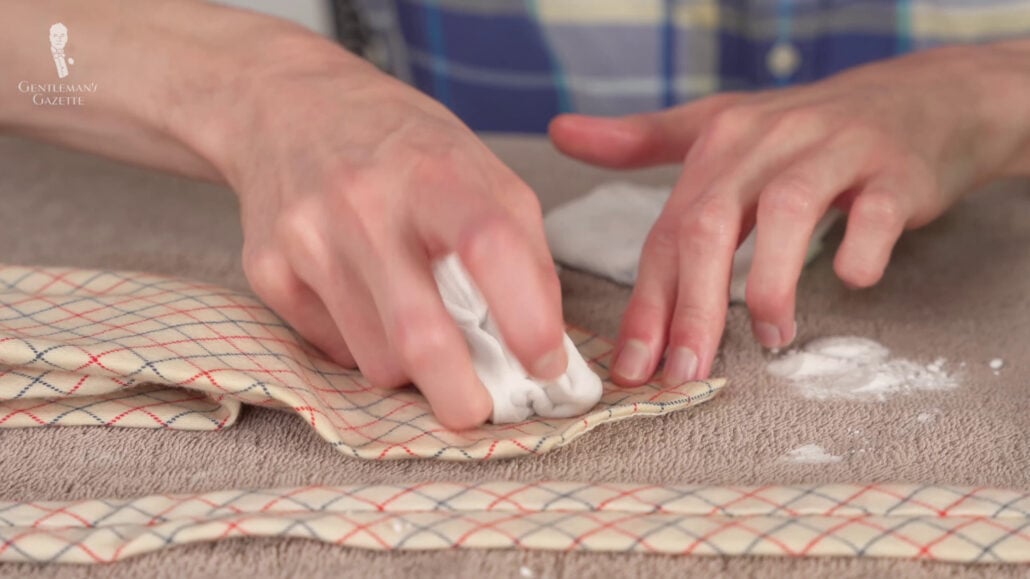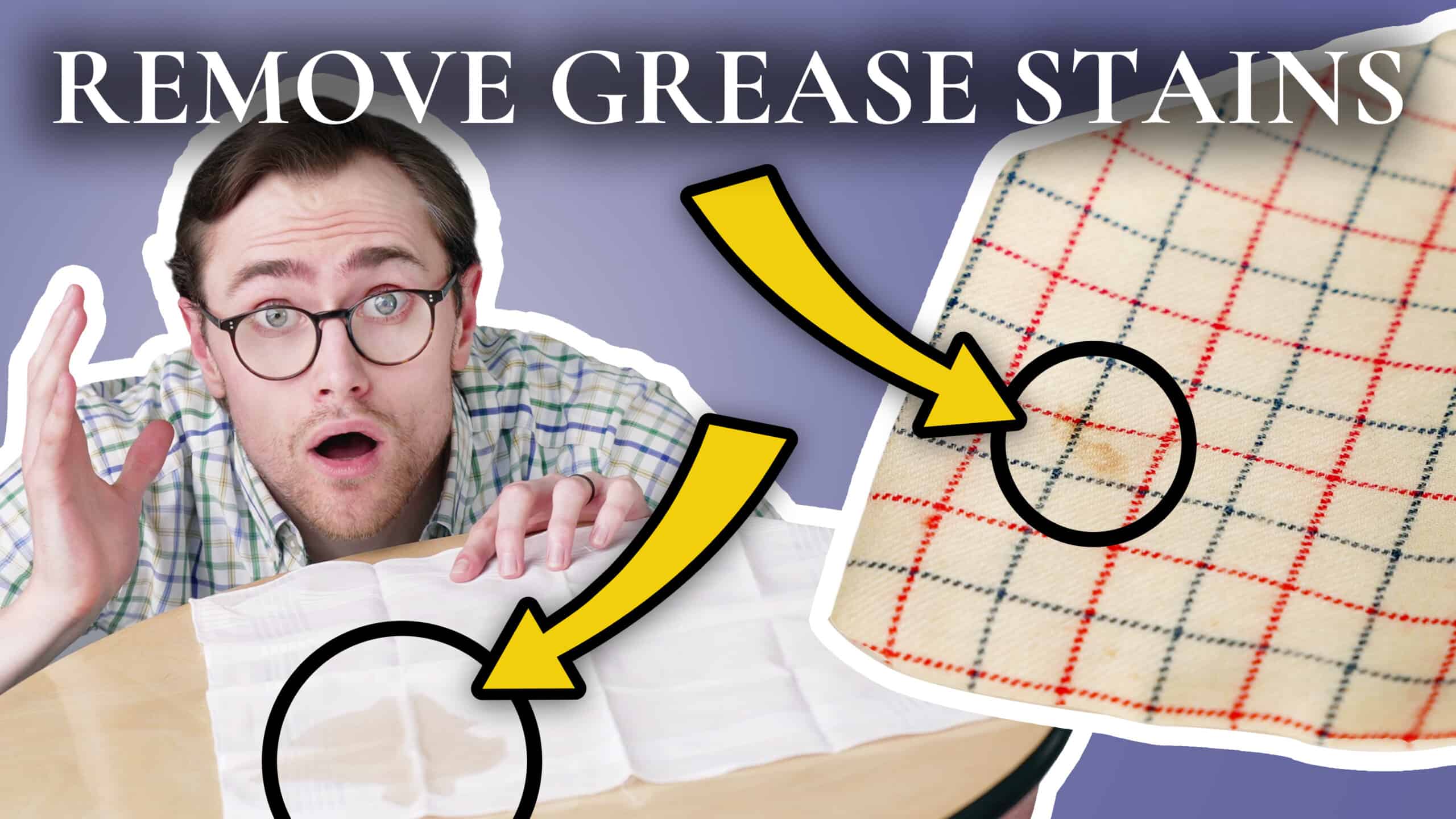Let’s face it: a grease stain is never good, especially on your well-curated clothes! Moreover, it’s not easy to remove. So, we’re going to share tips to remove pesky grease stains from any fabric.
Today’s guide is another installment in our ever-expanding collection of stain removal guides.
Stain Removal Guides
Understanding Grease Stains
First, to better combat grease stains, it helps to understand what they are. Grease stains come from oily organic or inorganic materials consisting primarily of fatty compounds or petroleum respectively.

The most common types are derived from vegetable oil, dairy and animal fats, and industrial lubricants. They’re semi-solid at room temperature, becoming liquid at higher temperatures. Most greases are pale or golden yellow in color, but they can become brown with age or in high concentrations.
Also, terms like “grease” and “greasy” are often colloquially applied to other potential stain sources like body oils, sweat, or products like “hair grease.” These stains might not necessarily be constituted from action grease, however, and may require different techniques for removal. So, you can peruse our comprehensive stain removal guide for more information.

Meanwhile, actual grease is a water-insoluble lipid, meaning that it’s a fatty, tacky substance that doesn’t dissolve well in water. So, it tends to cling to fabrics and is difficult to remove in most conventional washing cycles. And if that weren’t annoying enough, certain types of grease are practically colorless. So they’ll stain your clothes but not visibly, at least not until they attract dirt and grime, which are then going to color the fabric.
You’re most likely to encounter grease stains when cooking as sizzling fats and oils leap out of the pan and onto your clothes or when eating as oils, butter, and rendered fats drip out of your food and onto your shirt front.


Grease stains can sometimes result from personal products like lotions or creams as well, as they rub off from your hair or skin and onto your clothing. But, to determine if stains from these products should be treated like grease stains, read the ingredients list to see if you can identify lipids or fats.
Finally, here, many mechanical care products have grease as lubricating agent like greases, oils, and lubes for bicycles, cars, and other types of engines, especially if they’re automatic, systematic, and hydromatic.

How to Remove Grease Stains – General Tips
Now that we better understand grease stains, let’s get to work on removing them. In general, for grease stains on any fabric, it’s best if you act as quickly as possible.
1. Remove any excess grease

First, you should remove any excess grease by blotting or dabbing at the stain with a clean cloth or paper towel, but don’t scrub. If the grease has dried, you can try your best to scrape away the top dried layer with something like the edge of a spoon, but work delicately.
2. Sprinkle desiccants like baking soda, cornstarch, or salt onto the stain

Next, to draw out as much grease as possible, sprinkle desiccants like baking soda, cornstarch, or salt onto the stain and let it sit for at least 10 minutes. And, of course, if the desiccants become immediately soddened with grease, then remove them and reapply. For delicate fabrics like silk, don’t use baking soda or other potentially reactive ingredients.
3. Check the cleaning instructions for your garment before putting any cleaning agent on it


Next, before you apply any actual cleaning products to your garment, make sure to look for cleaning instructions on the garment tags if it has them. And if you’re especially concerned about potentially making any stains worse, then you can test out all of these cleaning tips on a discrete area of the garment, like the tails of a shirt or the back side of a tie.
Before applying any products, place something like an old towel or a piece of cardboard under the layer of the garment with the stain on it to prevent the stain from spreading around to other areas of the garment.
Removing Grease Based on Material Type
All of the stain removal steps we’re going to give you will depend on the type of fabric that you’ve got, so you can use the chapter selection tool below. And one final note here before we jump in: we’re going to be mentioning several different cleaning products by name as examples today, but do keep in mind that this post is 100% not sponsored.
Cotton, Linen, or Synthetic Fabrics
First up, for our specific tips then, we’re going to cover what you should do with cotton, linen, and synthetic fabrics. Your best cleanser options here are going to be grease-fighting dish or hand soaps, with Dawn being a great example.


Grease-targeting, stain pre-treatments like Shout Advanced Grease Busting Foam or the Laundress Stain Solution, or a laundry detergent with enzymes like Presto! Biobased, Arm & Hammer Plus Oxiclean, and Dirty Labs Detergent because these enzymes will help to break down the lipids of the grease stain.
Note, though ,that some of these products can be tough on fabrics. Dish soap, for instance, is meant for dishes, not necessarily for clothes. So, if you are concerned about damaging your fabric, a solution of water and white vinegar can also work, but it might require several applications and quite a bit of scrubbing as well.

Additionally here, because many greases have a high petroleum content, they can be especially hard to get out of synthetic fabrics because the molecules can partially bond together.
If you are using a stain pre-treatment, apply it according to its listed directions. If you’re using a detergent, mix it with water before applying it to the stain. And for liquid dish detergent and hand soaps, you can apply them directly to the stain without mixing them with water, but feel free to mix if you want to cut their power a bit.

Next, scrub the fabric against itself or use a soft brush like a toothbrush to activate the cleanser of your choosing. Work the cleanser into the stain and then repeat this process until the stain has vanished or at least noticeably reduced. Then, rinse out excess cleanser with the hottest water that’s still safe for the fabric.
Finally, wash the item according to its regular washing instructions in your machine; again, using the hottest water that’s safe for the fabric. Heat helps to work detergent deep into the fibers of the garment, but be careful not to go too hot as this could actually set the grease stain. Specifically, don’t set your machine above 104 degrees Fahrenheit or 40 degrees celsius, which is analogous to the hot setting on most North American washing machines.

Also, be sure to wash the garment by itself so that you prevent any remaining grease from transferring onto other garments. Once you’re done washing any formerly grease-stained item, leave it out to air dry. Don’t put a grease-stained garment into your dryer as, again, the heat inside will be likely to set the grease stain.
Wools and Knits


First, create a solution of cool water and a mild grease-fighting cleanser. You could use a mild dish soap or a mild enzyme detergent. Apply this solution to the stain, let it sit for a few minutes, and then soak the entire garment in a solution of Woolite or a comparable detergent and tepid water.
Finally here, hand wash the entire garment and then let it air dry. Remember not to wring out any woolen garments either, as this could make them misshapen. And on that note, you can consult our full guide to wool sweater maintenance.
Delicates like Silk


Next, we’ll come cover grease stain removal on delicate fibers like silk. Start here by sprinkling baby powder or talcum powder on the stain and letting it sit for several hours. Brush the powder off completely, then hand wash the garment with an appropriate cleanser like Studio by Tide, The Laundress Delicate Wash, or Heritage Park detergent.
Again, avoid scrubbing as this can bruise the fabric, and allow it to air dry completely.
Leather and Suede

Our final specific category here is removing grease stains from leather and suede. First, apply a mild desiccant like talcum powder or cornstarch to the stain and, again, let it sit for several hours. Remove the desiccant and then, clean the affected area with a dedicated leather or suede cleaner following its own instructions.
General Tips for Grease Stain Removal
For all of the fabric types and sets of instructions we’ve mentioned here today, keep in mind that you may need to repeat the processes several times to see your desired results.

So, between each attempt, it’s a good idea to take a picture of the stain to be able to measure whether you’re making progress or not. If you are making progress, then keep at it, as the stain should eventually vanish. But if the stain isn’t budging well, then it’s time to call in the cavalry.
If you’re dealing with a heavily set-in grease stain, then spray the affected area with a water displacement lubricant like WD-40. This will reactivate the stain, liquefying it, and hopefully making it easier to clean. WD-40 is, of course, a relatively heavy-duty product to be putting on your clothes. So instead, you could also use products like Murphy’s Oil Soap or a mechanic soap like Gojo or Fast Orange. Still, even these products have the potential to be relatively harsh, so they shouldn’t be used on delicate fabrics like fine wools, cashmere, or silk, except perhaps as a last resort and only with extreme caution.


Here, let your solvent of choice sit on the stain for 15 to 30 minutes, and then go through the steps we outlined for whatever the fabric happens to be. However, once you get to the end of the process, don’t wash the garment as you regularly would. Water displacement lubricants have a strong odor, and some of them can be flammable. So it’s best not to risk putting them in the washing machine and certainly not in the dryer.
Instead, soak the item in a solution of water and the appropriate detergent and then repeatedly hand wash the item until the scent of the lubricant is completely gone. You may also need to switch out your supply of water when hand washing a few times just to keep things clean as well. And once you’re done with this, be sure to let the item air dry completely.

After all of this, if your grease stain still hasn’t gone away, then it’s time to take the garment to the dry cleaners for some professional help. And with that, your grease stains should be gone.
Dry Cleaning 101
Conclusion
Stains on your favorite clothes are never fun, of course, but with the advice we’ve given you here today, grease stains shouldn’t be as big of a problem for you in the future.
If you’ve got any other effective grease stain removal tips that we missed today, be sure to let us know in the comments below.
Grease Stains FAQ
What is a grease stain?
Grease stains come from oily organic and inorganic compounds. Consisting primarily of petroleum or fats, they are derived from vegetable oils, dairy and animal fats, and industrial chemicals, usually with a yellow or brown color.
What causes grease stains?
You are most likely to encounter grease stains while cooking or eating, because fats and oils are regularly employed in the making and enjoying of meals. You can also find greases in certain personal products, like creams or lotions. Finally, grease is a common ingredient in lubricants for engines or vehicles like cars and bikes.
Why are grease stains so hard to clean?
Grease stains are so difficult to clean because grease is water insoluble. This means that it will not easily dissolve in water, requiring additional steps and special cleansers to break it down and lift the stain out of the fabric.
What cleaning products are best at removing grease from clothes?
The best cleaning products for removing grease are specifically formulated to fight grease. These include dishwasher detergents, grease-targeting stain pre-treaters, and enzyme-rich clothes washing detergents, because the enzymes are great at breaking down lipid stains.
How does fabric material affect grease stain removal?
Anytime you remove a stain, you want to be sure that you do not inadvertently do more damage to the garment you’re attempting to clean. In this guide, you will learn exactly how and with what products to remove grease so that you minimize the harm that the cleaning action does to the garment itself.
How do you clean an old grease stain?
Old grease stains can be cleaned by reactivating the patch of grease with a water displacement lubricant like WD-40. This process, however, involves some risk, so be sure to carefully follow the instructions outlined in this guide before attempting.
Outfit Rundown
Today, I’m wearing a relatively casual outfit good for sitting around the house and doing some stain removal and also good for the warm weather we are currently experiencing here in this Minnesota summer.
The central element is my short-sleeved sports shirt from Charles Tyrwhitt, which I’m wearing untucked for a casual feel, featuring a checked pattern in green, yellow, and blue on a white ground.
To harmonize with the shirt, I’ve chosen to wear some plain trousers in a true blue color, lighter than your standard navy, and also, for a playful touch, I’ve worn some green suede loafers from the brand Loake.
My socks today are from Fort Belvedere; they’re a relatively new addition to our shop in our shadow stripes but in colors of bright blue and yellow to go with the shirt and trousers.
I’m wearing my trusty coconut straw pork pie hat, and to go along with the casual feel, I’ve left product out of my hair and let my beard grow.
For a fragrance today, I’ve gone with the Marzocco scent from the Roberto Ugolini collection, as its vanilla tones provide a nice soft complement to the summer outfit I’m wearing. And, of course, you can find the socks I’m wearing today, along with the fragrance from the Ugolini collection and a wide array of other classic men’s accessories, by visiting the Fort Belvedere shop.





I don’t know if the original message went thru, I am sorry if this is a repeat. I got a stain on my Summer Poplin Cotton Dark Blue Suit. This stain was from a wax candle that someone blew on it to put out in my unfortunate direction :( Sadly I tried, with a piece of Brown Paper & Iron, got the “hard bulk” off, but a stain remained & I tried Alcohol figuring it was gentle, that did not work; finally I gave it to me numb-skulled cleaner.. no go! I am desperate any ideas from your resources? As I really loved this suit for the summer season. I would gladly take any professional advice that you can offer, I am saddened over what happened to my suit :( Please help me if you know any tips & tricks from your valuable resources, as I am desperate now ! Thank you 4anything that you can tell & advise me. Jim Demetrakis
Compressed air sprayed upside down?
I once got some olive oil on a pair a new linen pants while I was traveling in Mallorca. The waiter saw, brought over a spray that looked like the compressed air used for cleaning a computer keyboard, held the can upside down and sprayed the stain. He told me to hold the fabric away from my skin while he sprayed it. The spray froze the oil stain and surrounding fabric. Then he used fairly stiff brush to brush the frost and the oil stain away. I still have those pants, no oil stain!
My go to for tough stains is Brakleen in the red can. It has some of the chemicals used by dry cleaners. If this doesn’t get it out, I don’t know what will.
I have found the best defense against grease, or any stain, to be moist towelettes made for such instances. I know Tide and Shout both make these products and I can’t say that one is better than the other, as they both do the job. I keep these towelettes at home, in my desk at work, and in my cars and briefcase. This allows me to treat the stain immediately so as to prevent it from setting. Then when I launder the garment I can treat it again before the wash. I have never had a stain that couldn’t be removed.
Preston is fr doing the suitjak face in the thumbnail